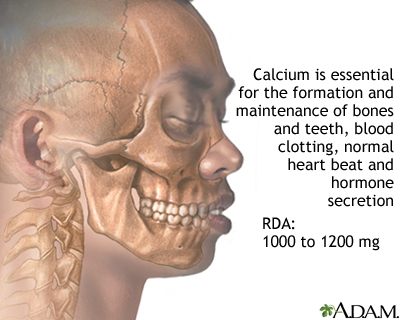The Food that Fuels You
Many people use the start of the new year as a reminder to get back into their diet and exercise routine, but it’s important that we maintain these healthy…

Update your location to show providers, locations, and services closest to you.
Calcium is the most plentiful mineral found in the human body. The teeth and bones contain the most calcium. Nerve cells, body tissues, blood, and other body fluids contain the rest of the calcium.
Diet - calcium
Calcium is one of the most important minerals for the human body. It helps form and maintain healthy teeth and bones. A proper level of calcium in the body over a lifetime can help prevent osteoporosis.
Calcium helps your body with:
CALCIUM AND DAIRY PRODUCTS
Many foods contain calcium, but dairy products are the best source. Milk and dairy products such as yogurt, cheeses, and buttermilk contain a form of calcium that your body can easily absorb.
Whole milk (4% fat) is recommended for children ages 1 to 2. Most adults and children over age 2 should drink low-fat (2% or 1%) milk or skim milk and other dairy products. Removing the fat will not lower the amount of calcium in a dairy product.
OTHER SOURCES OF CALCIUM
Other sources of calcium that can help meet your body's calcium needs include:
Calcium is often added to food products. These include foods such as orange juice, soy milk, tofu, ready-to-eat cereals, and breads. These are a very good source of calcium for people who do not eat a lot of dairy products.
Ways to make sure you get enough calcium in your diet:
DIETARY SUPPLEMENTS
Calcium is also found in many multivitamin-mineral supplements. The amount varies, depending on the supplement. Dietary supplements may contain only calcium, or calcium with other nutrients such as vitamin D. Check the label on the Supplement Facts panel of the package to determine the amount of calcium in the supplement. Calcium absorption is best when taken in amounts of no more than 500 mg at a time.
Two commonly available forms of calcium dietary supplements include calcium citrate and calcium carbonate.
Other types of calcium in supplements and foods include calcium lactate, calcium gluconate, and calcium phosphate.
Increased calcium for a limited period of time does not normally cause side effects. However, receiving higher amounts of calcium over a long period of time raises the risk for kidney stones in some people.
Those who do not receive enough calcium over a long period of time can develop osteoporosis (thinning of bone tissue and loss of bone density over time). Other disorders are also possible.
People with lactose intolerance have trouble digesting lactose, the sugar in milk. For this reason, they are often at risk for calcium deficiency. However, over-the-counter products are available that make it easier to digest lactose. You can also buy lactose-free milk at most grocery stores. Most people who do not suffer from severe lactose-intolerance are still able to digest hard cheeses and yogurt.
Tell your health care provider about any dietary supplements and medicines you take. Your provider can tell you if those dietary supplements might interact or interfere with your prescription or over-the-counter medicines. In addition, some medicines might interfere with how your body absorbs calcium.
The preferred source of calcium is calcium-rich foods such as dairy products. Some people will need to take a calcium supplement. How much calcium you need depends on your age and sex. Other factors, such as pregnancy and illnesses, are also important.
Recommendations for calcium, as well as other nutrients, are provided in the Dietary Reference Intakes (DRIs) developed by the Food and Nutrition Board at the National Academies of Sciences, Engineering, and Medicine. DRI is a term for a set of reference intakes that are used to plan and assess the nutrient intakes of healthy people. These values, which vary by age and sex, include:
Dietary Reference Intakes for calcium:
Infants (AI):
Children and adolescents (RDA):
Adults (RDA):
Pregnancy and breastfeeding (RDA):
Up to 2,500 to 3,000 mg a day of calcium from dietary sources and supplements appears to be safe for children and adolescents, and 2,000 to 2,500 mg a day appears to be safe for adults.
The following list can help you determine roughly how much calcium you are getting from food:
Vitamin D is needed to help the body absorb calcium. When choosing a calcium supplement, look for one that also contains vitamin D.


Cosman F, de Beur SJ, LeBoff MS, et al. Clinician's guide to prevention and treatment of osteoporosis [published correction appears in Osteoporos Int. 2015 Jul;26(7):2045-2047]. Osteoporos Int. 2014;25(10):2359-2381. www.ncbi.nlm.nih.gov/pmc/articles/PMC4176573/.
Institute of Medicine, Food and Nutrition Board. Dietary Reference Intakes for Calcium and Vitamin D. National Academies Press. Washington, DC. 2011. PMID: 21796828 pubmed.ncbi.nlm.nih.gov/21796828/.
Markell M, Siddiqi HA. Vitamins and trace elements. In: McPherson RA, Pincus MR, eds. Henry's Clinical Diagnosis and Management by Laboratory Methods. 24th ed. Philadelphia, PA: Elsevier; 2022:chap 27.
Mason JB, Booth SL. Vitamins, trace minerals, and other micronutrients. In: Goldman L, Schafer AI, eds. Goldman-Cecil Medicine. 26th ed. Philadelphia, PA: Elsevier; 2020:chap 205.
National Institutes of Health website. Dietary supplement fact sheet: calcium. ods.od.nih.gov/factsheets/Calcium-HealthProfessional/. Updated August 17, 2021. Accessed September 13, 2021.
US Department of Agriculture. FoodData Central. fdc.nal.usda.gov/index.html. Accessed May 5, 2021.
Many people use the start of the new year as a reminder to get back into their diet and exercise routine, but it’s important that we maintain these healthy…

The milk aisle at supermarkets these days can be intimidating. Long gone are the days of simple dairy; the shelves are now lined with a variety of milk options…
